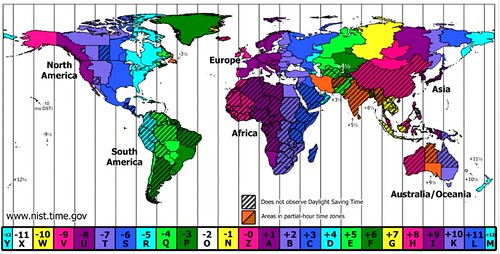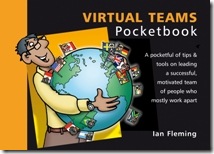Telephone conference calls are a great way for a geographically dispersed project team to stay in touch. The biggest problem is timing. If you are working in Britain, with colleagues in California, what time should you make the call?

A quick look at a map of time-zones reveals the problem. At noon British Time, it is 4am in California. Let’s say you are planning a 90 minute call. Typically, nobody likes getting up in the early hours, so you have to either move the call back to late evening or early morning in California. Let’s try them out:
Option A: Start at 9pm California; 5am Britain
Option B: Start at 9am California; 5pm Britain
My guess is that both parties will prefer Option B. The British won’t have to get up unrealistically early and the American’s won’t have to stay at work late. But this does mean that, while the Californian’s are bright as a button, the British are tired, at the end of the working day, staying on to 6:30.
The Challenges of Virtual Team
This is one tiny example of the challenges facing virtual teams – teams that do not work together physically. They are an increasing feature of the modern workplace. Even if your business is not a global or multi-national company, you are not immune.
Many small businesses work in complex global networks contributing products and services to international supply chains. Even many schools are now linking up across continents to enrich pupils’ learning opportunities.
 In his Virtual Teams Pocketbook, Ian Fleming is spot on when he identifies technology as a key enabler, and also crushes the assumption that virtual teams are all about technology. What Ian does do is give practical advice about using a range of technology tools to your advantage.
In his Virtual Teams Pocketbook, Ian Fleming is spot on when he identifies technology as a key enabler, and also crushes the assumption that virtual teams are all about technology. What Ian does do is give practical advice about using a range of technology tools to your advantage.
It is all about Communication
Technology is an enabler for the most important part of team working: communication. Whether your team is spread around offices across the world, or a series of local organisations, your top priority is to find the best ways to allow team members to stay in touch informally and to exchange formal information reliably.
Swift trust
In his Pocketbook, Ian Fleming describes a great process, called Swift Trust. The idea was developed by three authors called Meyerson, Weick and Kramer in 1996. Their thesis is that trust can be built quickly by :
- Presuming each team member has earned their place
- Trusting other people’s expertise and knowledge
- Creating shared goals and a shared recognition/reward scheme
- Defining a clear role for each person to play
- Focusing on tasks and actions
- Taking responsibility and acting responsively
Yes Please
How many groups have you worked in where one or more of these characteristics is missing. Deep trust comes from the one thing Swift Trust is designed to do without, personal relationships. However, surely each of the six characteristics above is essential for any team.
So here’s the deal
Whether your team is virtual or sitting around the same table, day after day, tailor your communications to build trust. Focus on the checklist above, and then look for ways to build personal relationships too.
